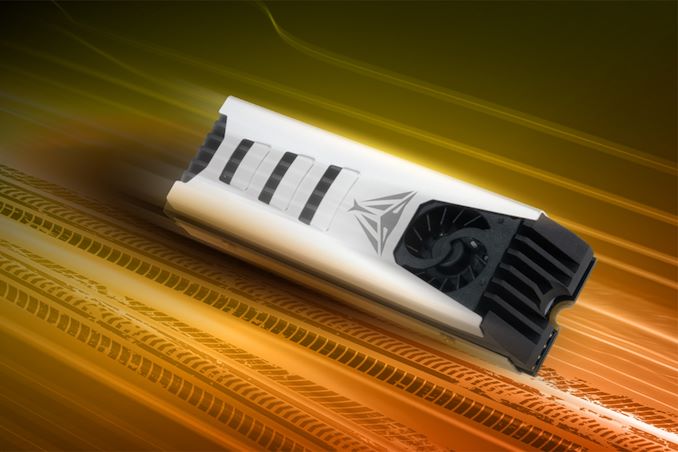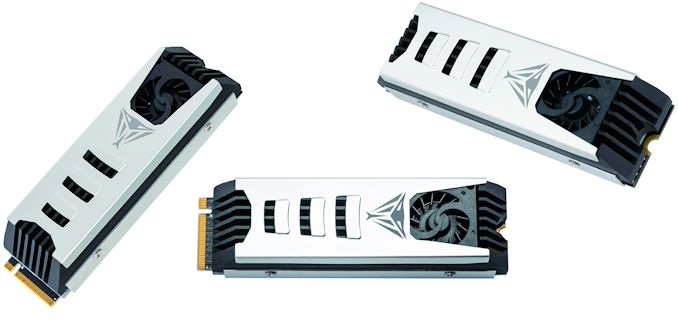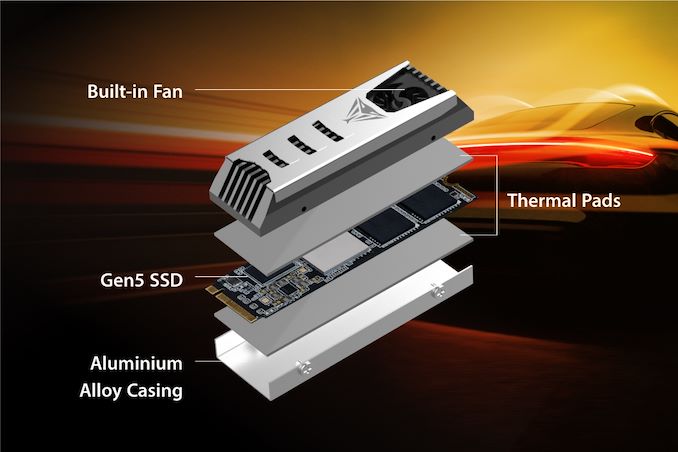Patriot Reveals Viper PV553 SSD: 12.4 GB/s with a Blower Fan
by Anton Shilov on February 7, 2024 7:30 PM EST
Patriot has formally introduced its first solid-state drives featuring a PCIe 5.0 x4 interface aimed at demanding users. The Viper PV553 SSD uses the company's all-new active cooling system boasting an aluminum radiator, a blower fan, and a special heat shield that promises to ensure the best possible cooling for consistent performance under high workloads.
Set to be available in 1 TB, 2 TB, and 4 TB configurations, Patriot's Viper PV553 uses Micron's 232-layer 3D TLC NAND memory and we presume Phison's PS5026-E26 controller as Patriot is a loyal partner of the Taiwan-based SSD controller developer.
As for performance, Patriot rates its 2 TB and 4 TB PV553 for sequential read/write speeds of up to 12,400 MB/s and 11,800 MB/s as well as up to 1.4 million random 4K read and write IOPS. Meanwhile, the 1 TB model is slightly slower and offers read/write speeds of up to 11,700 MB/s and 9,500 MB/s as well as up to 1.3/1.4 million read/write IOPS.
The drives come in an M.2-2280 form-factor and are compatible with desktops that have sufficient space inside as Patriot's Viper PV553 SSDs are equipped with quite an extraordinary cooling system to take away 11W of thermal power that they can dissipate. The cooler (which features a 16.5 mm z-height) employs a rather big aluminum radiator that covers both the controller and memory chips, a blower fan, thermal pads on both sides of the drive, and an aluminum casing — which the company calls heat shield — that directs air produced by the fan through the radiator's fins to maximize cooling performance.
The extensive cooling is supposed to ensure that Patriot's Viper PV553 drives sustains performance even under severe workloads. In fact, Patriot says that the cooler ensures that the drive maintains temperature at about 45ºC in normal room temperature conditions.
Meanwhile, PV553 SSDs are not Patriot's fastest drives. Recently the company demonstrated its Viper PV573 SSDs that use Micron's B58R 3D TLC NAND with a 2400 MT/s data transfer rate and offer a sequential read and write speed of up to 14,000 MB/s and 12,000 MB/s, respectively. That drive will perhaps get more benefits from the new cooling system, but it will be available at a later date.
As it is always the case with Patriot's premium SSDs, the Viper PV553 drives are backed by a five-year warranty and are guaranteed to sustain 700, 1400, and 3000 terabytes to be written.
Source: Patriot












14 Comments
View All Comments
web2dot0 - Wednesday, February 7, 2024 - link
Comically stupid to have active cooling on an ssd.Not practical in mobile and power consumption is through the roof.
Totally useless in consumer level devices. The future is mobile, not desktop.
Samus - Wednesday, February 7, 2024 - link
Just imagine the noise from that little shit fan when the bearings go, I'm sure it's a great quality fan lolSoulkeeper - Wednesday, February 7, 2024 - link
They are nearly useless.They don't even use copper or have a mirror finish for the contact area.
It's similar to dimm heatsinks or the old chipset/gpu heatsinks which had a 50 grit or worse sanding job. I'm guessing whatever thermal tape/compound they use is basically the worst on the market also.
meacupla - Thursday, February 8, 2024 - link
Ugh, where to start...1. These are packaged chips and not naked silicon. If you have ever run your finger over the black plastic on DRAM, you might notice they are not smooth.
2a. They are using a thermal pad anyways. Unlike thermal paste, when you use a pad, the only important things are flatness, evenly distributed pressure, and proper contact.
2b. SSDs are comprised of multiple BGA chips. They have to use a thermal pad, because each SSD will have height discrepancies between each chip. It is well established practice to use thermal pads in such instances. For example GPU DRAM and MOSFETS get their own heatsink and use thermal pads.
3. It's not 50 grit. Have you ever used 50 grit sandpaper? That stuff is used to flatten out lumps. The base of heatsinks for SSDs is more like 400 grit, but very flat.
4. A mirror finish base plate contact area does not improve performance anyways. Being flat and having 800-1200 grit smoothness is plenty for peak performance when used on naked silicon.
Now, does this Patriot SSD heatsink leave a lot to be desired? Yes.
I would have used a nickle plated copper base with soldered on aluminum fins for at least double the fins and surface area.
These SSDs apparently run cool enough with 7 thick fins and a rear plate.
deil - Thursday, February 8, 2024 - link
Try even fitting this into a laptop. GOOD LUCK.in most cases laptops need ones that are without heat shield, and use laptop provided cooling or
slower or ones that somehow can fit those 2mm thick copper slabs, just for thermal capacity not cooling.
kn00tcn - Thursday, February 8, 2024 - link
wtf does a laptop need 12MB/s for?? wtf is so wrong about having a variety of products and performance tiers??Samus - Thursday, February 8, 2024 - link
12MB/s!? Pfft. Bro my whip has 20MB/s!jmke - Thursday, February 8, 2024 - link
> The future is mobile, not desktop.the future is the best tool for the job at hand; be it mobile or desktop, or remote;
no reason to be exclusive
web2dot0 - Thursday, February 8, 2024 - link
Vision Pro says otherwise 😂shabby - Thursday, February 8, 2024 - link
What does it say?